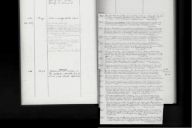From One Collection to Another
After its establishment in 1858, the Royal Dutch Antiquarian Society focused its efforts on creating a collection that represented the Dutch national history and identity. They were closely involved in the conception of the Rijksmuseum, and provided a large part of their collection to the new museum as a long-term loan. Even now, the Society resumes its research and acquisition efforts in order to make the Dutch national heritage available to the public.
When considering the tremendous efforts of the Society, it is not strange that a lone pair of slippers entered the Rijksmuseum collection with nothing but a short note describing the object (see fig. 1). The full note reads:
“A pair of lady’s slippers of red embroidered silk. Ascending, broad toe box with a flattened nose, decorated with vines, sequins and ornamental borders. Flat, incorporated heel. Double sole and cloth-lined midsole. Insole of fiery red leather. 21 centimeters long.”
Cultural knowledge can slip away when an object is removed from its original place in society, either by distance, time, or both. Throughout history, plenty of pieces have been collected without a full understanding of their significance. These objects can present interesting challenges to museums or other institutions looking to rethink their existing collections. But sometimes, despite the best efforts of the curators, conservators and researchers, information is simply lost.
However, this new age of connectedness presents the opportunity to look at collected objects with fresh eyes. We are now able to share research, information, and even personal experiences, regardless of borders and language barriers. We have the capability and the resources to come together and reshape the way we collect and share knowledge, like we do here on ThingsThatTalk.
With that in mind, let us take a closer look at these shoes. Perhaps they themselves can tell us a bit about their history.
